CBSE Class 10 Maths Sample Paper 2024-25: The 2025 sample paper for CBSE Class 10 Mathematics (Basic) is out on the official website of the Central Board of Secondary Education (CBSE). The sample question paper is provided along with the solved marking scheme to help students know the paper structure and right to tackle the questions.
Solving the sample papers is crucial to experience the pressure of a real exam. It develops time management and answering skills. Unlike entrance exams, CBSE demands elaborative answers, and thus having a look at the marking scheme is a must. Scroll down to check the question paper design, CBSE Class 10 Maths (Basic) sample paper 2024-25, and its solutions.
CBSE Class 10 Maths (Basic) Question Paper Design 2024-25
Here's a tabular format for the question paper design based on the details given in CBSE 10th Maths Basic sample paper 2024-25.
| Section | Question Numbers | Question Type | Marks per Question | Total Questions | Total Marks | Internal Choice |
| A | 1 - 18 | Multiple Choice Questions (MCQs) | 1 | 18 | 18 | None |
| 19 - 20 | Assertion-Reason Based Questions | 1 | 2 | 2 | None | |
| B | 21 - 25 | Very Short Answer (VSA) Questions | 2 | 5 | 10 | 2 Questions |
| C | 26 - 31 | Short Answer (SA) Questions | 3 | 6 | 18 | 2 Questions |
| D | 32 - 35 | Long Answer (LA) Questions | 5 | 4 | 20 | 2 Questions |
| E | 36 - 38 | Case Study-Based Questions (with sub-parts of 1, 1, and 2 marks each) | 4 | 3 | 12 | Provided for each question |
| Total | - | - | - | 38 | 80 Marks | - |
Additional Instructions:
- All questions are compulsory.
- Draw neat figures wherever required.
- Use π = 22/7 as directed if not specified otherwise.
- Calculators are not permitted.
This layout provides a structured view for both teachers and students to follow the question paper's format effectively.
CBSE Class 10 Maths Basic Sample Paper 2024-25
The sample questions for Mathematics Basic Class 10 are given below which can be solved and their answers can be checked from the marking scheme.
| Section A | ||||||||||||||||
| Section A consists of 20 questions of 1 mark each. | ||||||||||||||||
| 1 | HCF OF (33 × 52 × 2), (32 × 53 × 22) 𝑎𝑛𝑑 (34 × 5 × 23) is (A) 450 (B) 90 (C) 180 (D) 630 | 1 | ||||||||||||||
| 2 | The system of linear equations represented by the lines l and m is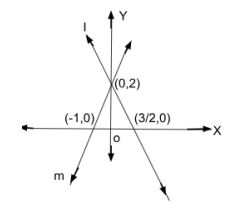 (A) consistent with unique solution (B) inconsistent (C) consistent with three solutions (D) consistent with many solutions | 1 | ||||||||||||||
| 3 | The value of k for which the quadratic equation 𝑘𝑥2 − 5𝑥 + 1 = 0 does not have a real solution, is (A) 0 (B) 25/4 (C) 4/25 (D) 7 | 1 | ||||||||||||||
| 4 | The distance between the points (𝑎, 𝑏) and (−𝑎, −𝑏) is (A)√𝑎2 + 𝑏2 (B) 𝑎2 + 𝑏2 (C) 2 √𝑎2 + 𝑏2 (D) 4√𝑎2 + 𝑏2 | 1 | ||||||||||||||
| 5 | In the given figure, PQ and PR are tangents to a circle centred at O. If ∠QPR=35∘ then ∠QOR is equal to 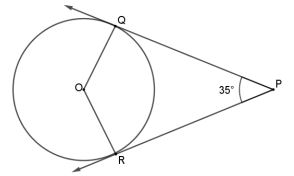 (A) 70∘ (B) 90∘ (C) 135∘ (D) 145∘ | 1 | ||||||||||||||
| 6 | If △ 𝐴𝐵𝐶 ∼△ 𝑃𝑄𝑅 such that 3AB = 2PQ and BC=10 cm, then length QR is equal to (A) 10 cm (B) 15 cm (C) 20/3 cm (D) 30 cm | 1 | ||||||||||||||
| 7 | If 3 cot 𝐴 =4, where 0° < 𝐴 < 90°, then sec 𝐴 is equal to (A) 5/4 (B) 4/3 (C) 5/3 (D) 3/4 | 1 | ||||||||||||||
| 8 | In the given figure, 𝛥𝐵𝐴𝐶 is similar to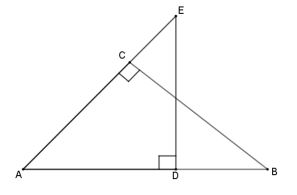 (A) 𝛥𝐴𝐸𝐷 (B) 𝛥𝐸𝐴𝐷 (C) 𝛥𝐴𝐶𝐵 (D) 𝛥𝐵𝐶𝐴 | 1 | ||||||||||||||
| 9 | If H.C.F(420,189) = 21 then L.C.M(420,189) is (A) 420 (B) 1890 (C) 3780 (D) 3680 | 1 | ||||||||||||||
| 10 | The 4𝑡ℎ term from the end of the A.P −8, −5, −2, … ,49 is (A) 37 (B) 40 (C) 1 (D) 43 | 1 | ||||||||||||||
| 11 | In the given figure, if △ 𝑂𝐶𝐴 ∼△ 𝑂𝐵𝐷 then ∠𝑂𝐴𝐶 is equal to (A) 58∘ (B) 55∘ (C) 128∘ (D) 52∘ | 1 | ||||||||||||||
| 12 | If perimeter of given triangle is 38 cm, then length AP is equal to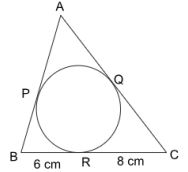 (A)19 cm (B) 5 cm (C) 10 cm (D)8 cm | 1 | ||||||||||||||
| 13 | 1−𝑡𝑎𝑛230∘ /1+𝑡𝑎𝑛230∘ is equal to (A) cos 60∘ (B) sin 60∘ (C) 1 (D) 𝑡𝑎𝑛260∘ | 1 | ||||||||||||||
| 14 | The total surface area of solid hemisphere of radius 𝑟 is (A) 𝜋𝑟2 (B) 2𝜋𝑟2 (C) 3𝜋𝑟2 (D) 4𝜋𝑟2 | 1 | ||||||||||||||
| 15 | Which of the following cannot be the probability of an event? (A) 0.4 (B) 4% (C) 0.04% (D) 4 | 1 | ||||||||||||||
| 16 | The roots of quadratic equation 3𝑥2 − 4√3𝑥 + 4 = 0 are (A) not real (B) real and equal (C) rational and distinct (D) irrational and distinct | 1 | ||||||||||||||
| 17 | The following distribution shows the marks distribution of 80 students.
(A) 20-30 (B) 40-50 (C) 30-40 (D) 10-20 | 1 | ||||||||||||||
| 18 | A quadratic polynomial whose zeroes are 2/5 𝑎𝑛𝑑 −1/5 is (A) 25𝑥2 + 5𝑥 − 2 (B) 5𝑥2 − 2𝑥 + 1 (C) 5𝑥2 + 2𝑥 − 1 (D) 25𝑥2 − 5𝑥 − 2 | 1 |
To download this complete sample paper and its marking scheme, click on the links below:
| Download CBSE Class 10 Maths Basic Marking Scheme 2024-25 PDF |
Also Check:
- CBSE Class 10 Sample Paper 2024-25 PDFs
- CBSE Class 10 Sample Papers 2025 For Skill Subjects
- CBSE Class 10 Maths CBQs Chapter-Wise PDFs
- CBSE Class 10 Syllabus 2024-25 (All Subjects)
- CBSE 2025 Board Exam Dates Announced For Class 10
- CBSE Class 10 Competency-Focused Questions 2024-25.
- CBSE Class 10 - Online Mock Tests and Video Courses
- CBSE Class 10 Syllabus 2024-25 (All Subject PDFs)
- CBSE Class 10 Deleted Syllabus 2024-25 (All Subject PDFs)
- NCERT Class 10 Revised Textbooks (All Subject PDFs)
- CBSE Board Exams Twice A Year: Check Updates Here
- CBSE Additional Practice Questions for CBSE Board Exam 2024
- CBSE Class 10 Sample Papers for Board Exam 2024 with Solutions
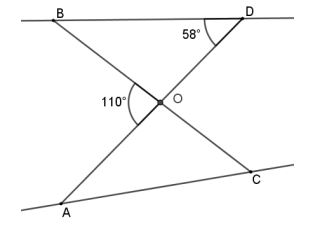
Comments
All Comments (0)
Join the conversation